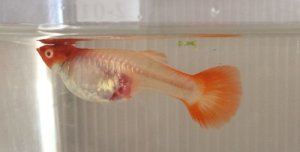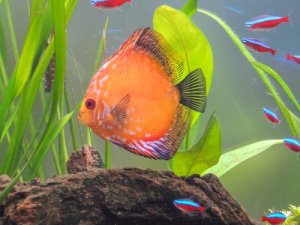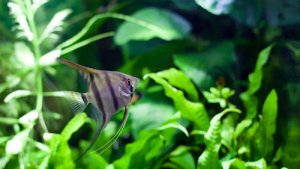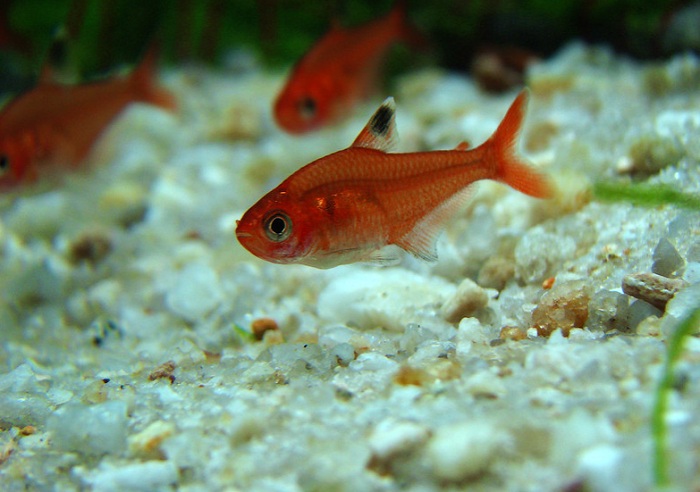
The Red Phantom Tetra is a great, lesser-known Tetra species for those who want a small and peaceful tankmate for a larger community tank. It has an unusual shape in comparison to classic Neon, Rummynose, and Cardinal Tetras, but is nevertheless a friendly schooling fish that comes in quite a wide color variation. Read on to find out how to take care of these Amazonian Tetras.
Breed Overview
| Origin | Venezuela |
| Lifespan | 5-7 years |
| Size | 1.5” or 2-3 cm |
| Colors | Red to see-through, and generally translucent |
| Food | Omnivores |
| Tank Size | Minimum 20 gallons or 76 liters |
| Temperament | peaceful but curious |
| Water Type | Freshwater |
| Water Temperature | 68-78 F or 20-26 C (preferring the lower end) |
| Water pH | 5-8 |
Appearance
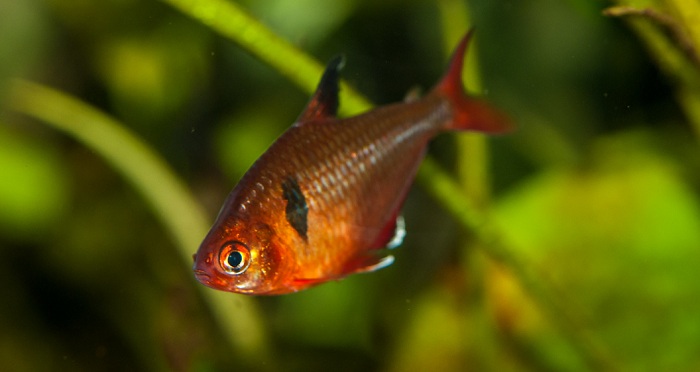
The Red Phantom Tetras, as its name might suggest, is a relatively vivid red color. This can appear more like ruby red, or more like rusty red, depending on water conditions, lighting, and other factors.
The ‘phantom’ part of their name refers to the fact they are slightly translucent, and you can partially see through their bodies. This would make them harder to spot predators in their natural habitat.
Red Phantom Tetra Size And Shape
Red Phantom Tetras have a heftier, more rounded shape than their streamlined counterparts like the Rummynose Tetra, Neon, or Cardinal Tetras. However, they still reach only 1.5” or 2-3 cm.
Due to their more squarish shape, you may suspect they are related to Rasboras. However, they are true Tetras and like others in their family, they have small bodies and an adipose fin on the caudal peduncle (near the fish’s tail), giving them a striking shape.
Color Variation
It’s the dark red color that gives these fish their name, but you may see some that are paler or less pale in nature. For example, some may just be a very translucent red and others may almost appear see-through. In truth, these fish are spread out across a wide habitat where conditions vary. Sometimes the pH is lower or higher, and the rivers they live in get very different light levels.
Science hasn’t quite found out precisely the factors that alter the color of these Tetras but it’s safe to say there are many due to how large their range is. Ultimately, your fish’s color may just be down to their genetics. However, keeping them well-fed on an enriched diet and with minimal stress is a good way to ensure they are putting on their full display.
Author’s Note: One very appealing thing about this species is the contrast of their fins with the rest of their bodies. These guys have black and white tipped fins that stand up straight on their backs and make them seem bigger than their 1.5-inch length would suggest. These bold colors make them easy to spot even in a well-planted aquarium.
Tank Setup And Maintenance
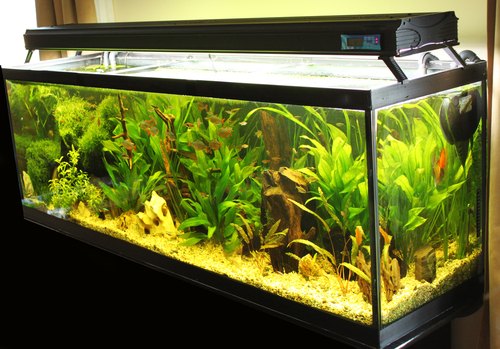
Environment
Setting up a Red Phantom Tetra tank depends mostly on if you want to keep any other tankmates with them. If you just want to keep Tetras by themselves, an aquarium of a minimum of 20 gallons or 76 liters will be fine. However, if you are keeping larger tankmates, you can adapt your conditions to the requirements of the larger tankmate to make things easier, while ensuring they match your Tetras in terms of pH and water temperature
- Filtration
Depending on the size of your tank and other tankmates, there are a variety of filter options. For just a small Tetra tank, a basic sponge filter will do. A good flow rate is 4x the tank capacity per hour.
If you have a larger tank with other species, you may need a canister or hang-on-back filter. These are more powerful and should never be used in a small Tetras tank or your Tetras will get sucked against it, even though these guys are relatively strong swimmers.
- Conditions
Red Phantom Tetras can survive across a wide variety of pH ranges as well as temperatures due to the variation in their native habitat of the Rio Orinoco.
However, they are one of the Tetra species that like cooler water, closer to the subtropical end of the range than the tropical end. If the water temperature gets too high, it can very easily cause this fish to be stressed. It also means bacteria breed more easily in the tank water.
Plants
These are shy fish, so planting your tank heavily is a must to ensure they can hide amongst the plants. This helps them feel safe and provides refuge from bolder, more aggressive tankmates.
To properly create a planted tank, buy the appropriate species and then plant bare roots in some aquarium soil, which will allow them to establish. You can leave some time before introducing your fish after this, potentially up to a month.
The longer you let the tank establish, the more likely you are to create an equilibrium that ensures it has great water quality when you finally introduce your fish.
To cover the aquarium soil you can use either a sand, gravel, or smooth pebble substrate. It really depends on what other tankmates you have. For example, if you want to include plecos, a gravel substrate is not recommended as it can hurt their sensitive stomachs. However, your Tetras will be fine with anything.
Tankmates
Red Phantom Tetras can survive under a very wide pH range, from 5 to about 8. As a result, there are lots of different tankmates they can par will with.
The biggest thing to take into account is aggression. You should never pair your fish with larger, predatory cichlids like Oscars, which will feed on your fish. Likewise, other large Amazonian predators like arowana and piranhas are not a good match.
However, peaceful or hierarchical Amazonian fish like discus fish or angelfish are a great choice if you want a larger tank. Other good tankmates include:
- Other Tetras such as Neon, Cardinal, Rummynose, and Black Phantom Tetras
- Cory Catfish, Oto Catfish, Plecos, Loaches, and other bottom-dwelling fish
- Small cichlids like the Electric Blue Ram
- Peaceful Barb species. Some Barbs can be aggressive, like the larger Denison’s Barb, but small, easygoing species like the Cherry Barb can work with these Tetras
- Other small fish, like Rasboras
- Gouramis
Feeding
Red Phantom Tetras are omnivores and would eat a variety of small crustaceans in their natural habitat. These include free-swimming invertebrates as well as other vegetable matter that might fall into the streams where they live.
You can feed them good quality flake food, which is small enough and soft enough to break off and fit into their small mouths. However, it’s always good to enrich their diet with both fresh and frozen protein such as fruit flies, mosquito larvae, brine shrimps, glass worms, blood worms, and other invertebrates.
To ensure they get a balanced diet occasionally you can feed them a few vegetables such as a bit of lettuce leaf for them to nibble on.
Behavior And Temperament
Red Phantom Tetras are shy fish, but not timid. They are schooling fish, so it’s good to get a group of at least five or six, although you can purchase up to ten if you have a large Amazonian tank. Schooling is a defense against predation in the wild.
They enjoy having lots of plants, so it’s really crucial you plant your tank – this is not optional. Phantom Tetras enjoy hiding in these plants when they feel threatened and as a result, the presence of plants and the associated hiding spots in the tank makes them feel safe.
Apart from this they will get used to other peaceful and friendly tankmates and may even follow them scavenging for food. However, they will largely keep themselves to their own school.
Author’s Note: Just like with any fish, there’s more to these guys than meets the eye. For example, when they are feeling particularly bold and playful, you may see individuals darting around in the middle of the shoal. This is normal, and it means your fish feel safe and happy.
Pests And Diseases
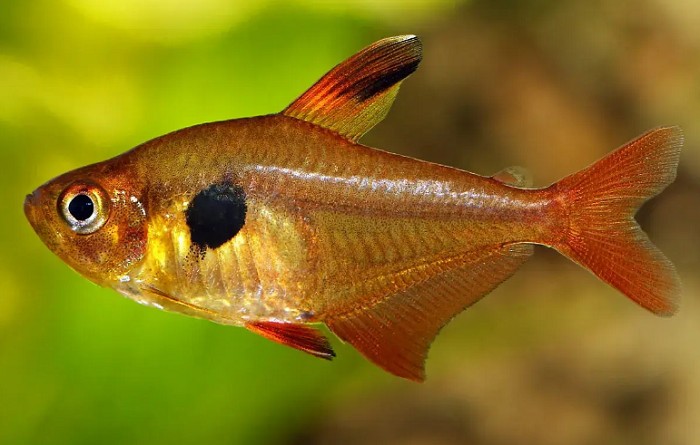
Red Phantom Tetras are generally hardy fish and they are prone to most of the same diseases as other small fish. The biggest factor in preventing these is good water quality. Providing your water quality remains high, it’s unlikely you’ll have to deal with any of these diseases. However, if you do, care is relatively similar to other Tetras like the Neon Tetra.
Swim Bladder Disease
Swim bladder disease is one of the most common ailments in fish of all sizes and shapes and the Red Phantom Tetra is no different.
Generally, it is caused by a bacterial infection of the fish’s swim bladder, an important organ that it uses to maintain position and balance in the water. Swim bladder disease means your fish will have trouble staying afloat and will roll from side to side or have difficulty balancing.
It’s good to use a quarantine tank to treat your fish so that the medication doesn’t affect the rest of the school. Swim bladder disease will clear up after a course of over-the-counter medication in most cases. You can buy this from your local aquatics store or online, or visit a specialist aquatic vet.
Digestive Issues
Digestive issues can happen in any fish and generally occur from overfeeding or from not feeding a balanced diet. Fish flakes are a good staple food for your Tetras. However, if your fish eat too much or too quickly, they can develop digestive upsets. You may even notice bloating in your fish’s stomach.
To heal this, simply cut back on the amount of food that you feed. It’s possible to go one day without food and still have your shoal be ok. You can also feel little pieces of blanched sweet potato or chopped-up pea that can help clear out the digestive tract.
Ich
Ich is a parasitic infection that manifests as white patches on your fish’s skin. It can be relatively noticeable in Red Phantom Tetras due to their unusual coloration. Ich is infectious, so it’s important to quarantine the fish early on and treat it with an antifungal treatment in a separate tank.
Author’s Note: How can you tell whether a fish is sick? Some early warning signs, even before you spot the parasite, include lethargy and loss of appetite. Ultimately, the disease isn’t about looking at just one symptom but about many.
Breeding
Surprisingly, even though some other Tetras are easy to breed, the Red Phantom Tetra is one of the harder species to get to mate in your aquarium. However, breeding is much the same as for any other Tetra species.
- Introduce your fish to a separate breeding tank. You can add a variety of male and female fish to see which pairs bond. You will need to provide them with an environment they feel safe to lay eggs.
This generally means adding lots of plant cover such as guppy grass, Marimo moss, or Java moss because these plants provide a sheltered spot for them to lay eggs.
- Wait for mating to happen. You will see the male chase the female until she drops her eggs and after this point, he will spray his milt. The Red Phantom Tetra can lay over 400 eggs in one go.
- Remove both the parents and all other fish from the breeding tank. Tetras are prone to eating their eggs and young.
- Wait for the eggs to act. Normally this takes no more than 36 hours to keep a close eye on the process. Not all eggs will hatch at once. When the fry hatch they may still be attached to their egg sacs which means they get all the food they need from this for the first few days. You will find they only start eating when they are big enough.
- Once the fry is big enough you can feed them on infusoria, which is a mix of microscopic invertebrates that fish fry would eat in the wild. Like their relatives the black skirt tetra, it takes 3-4 days before the fry can swim by themselves. As a result, you don’t need to worry too much until this stage.
Final Thoughts
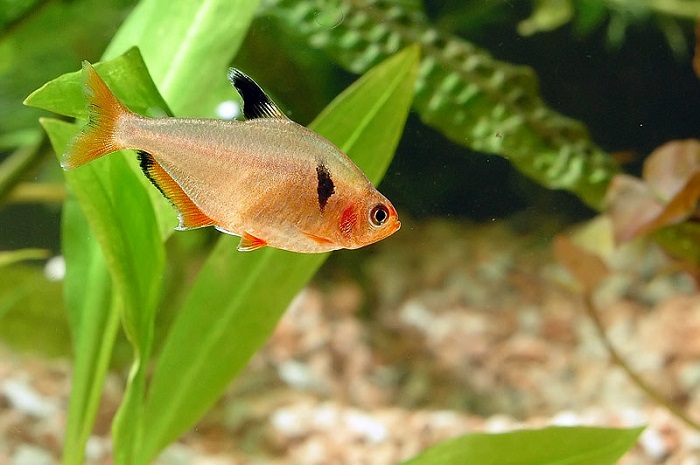
All in all, Red Phantom Tetras are a more unusual Tetras species that is attractive for its semi-translucent body. Although some aspects of their behavior are different and they are not as bold as other species, they make really great additions to any Amazonian tank and are a fantastic choice if you want something a bit different.


